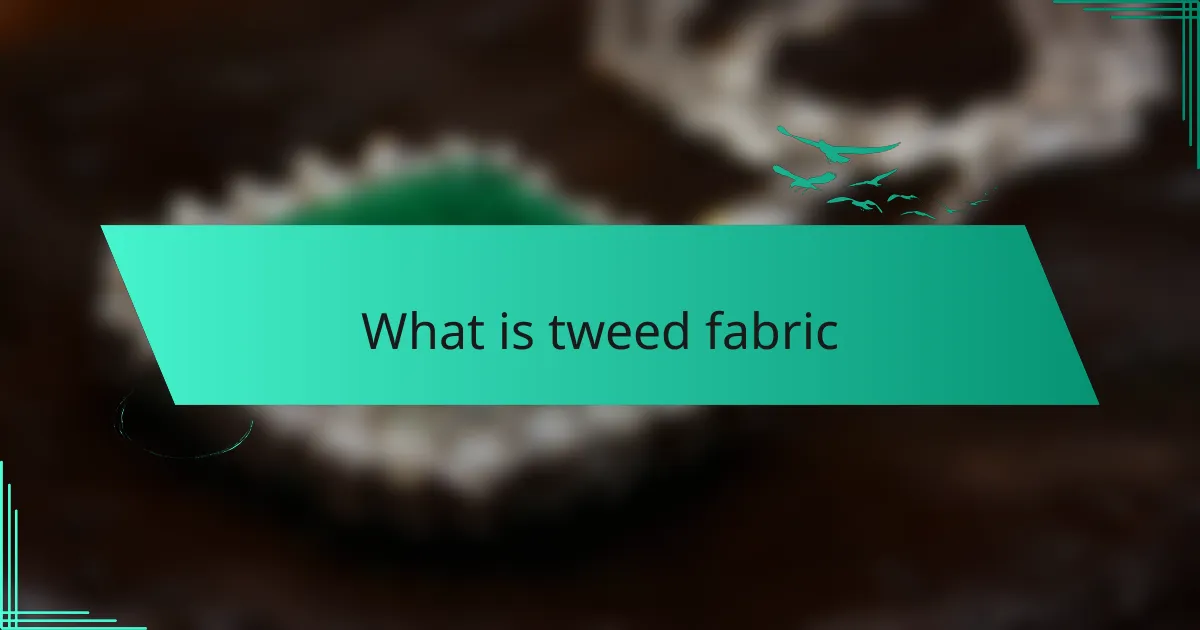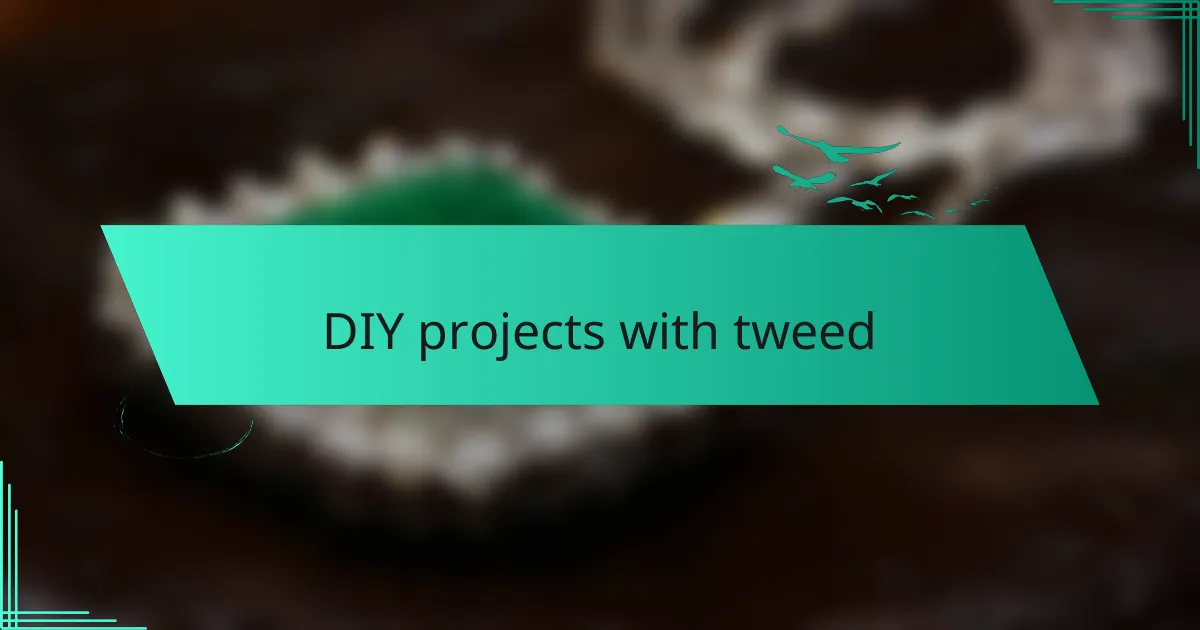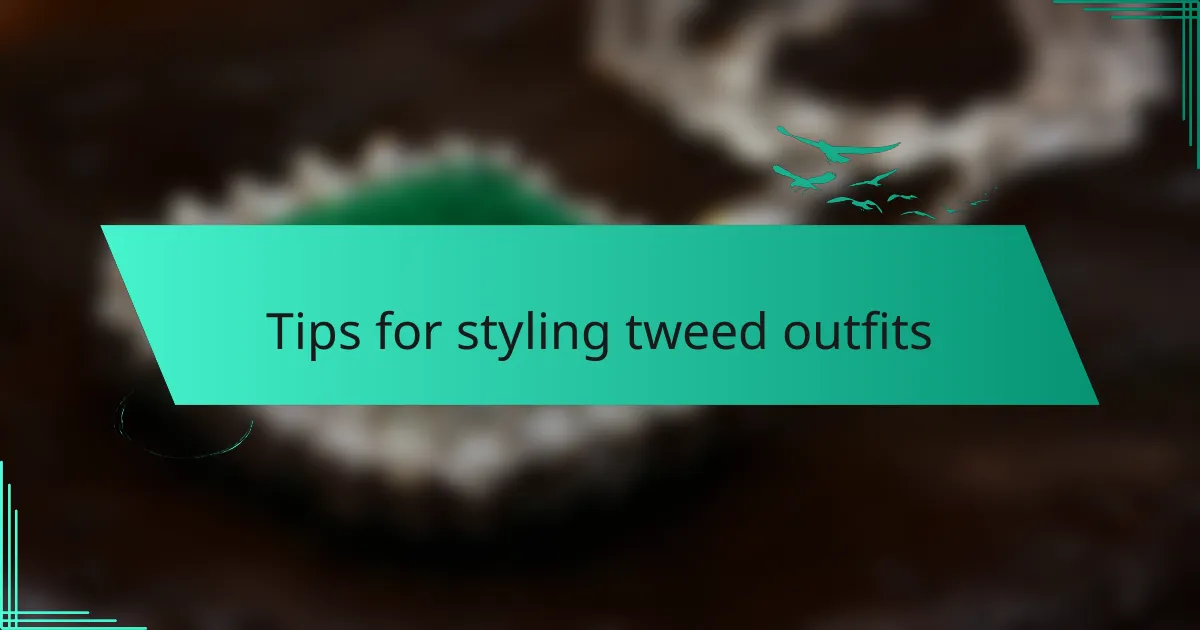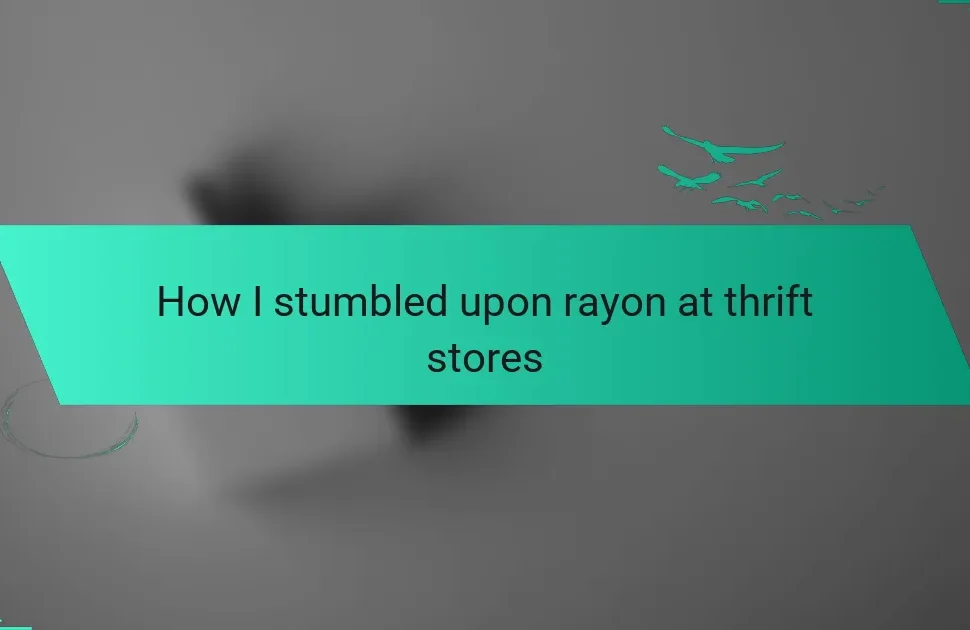Key takeaways
- Vintage fashion trends reflect the cultural values and stories of their time, with tweed representing a blend of warmth, durability, and craftsmanship.
- Tweed fabric, originating from the Scottish Highlands, is characterized by its unique weaves and patterns, making it a versatile choice for various styles.
- DIY projects with tweed can enhance personal style, allowing for creative transformations while celebrating the fabric’s history.
- Styling tweed outfits is enhanced by classic accessories and layering techniques, creating a timeless yet modern look.

Understanding vintage fashion trends
Vintage fashion trends are often a reflection of the culture and values of the times they come from. I remember flipping through old fashion magazines and being captivated by the unique styles that defined different eras. Have you ever wondered what stories those garments could tell? Each piece carries not only aesthetic charm but also the emotions and experiences of those who wore it.
Exploring vintage fashion is like diving into a treasure trove of history. When I first discovered tweed, I was struck by how it represented not just a fabric but an entire lifestyle steeped in the rugged beauty of the Scottish Highlands. Every stitch felt like a piece of the narrative, connecting me to a time when craftsmanship was paramount.
Understanding these trends requires an appreciation for their context. For instance, the way tweed emerged as a practical choice for the outdoorsy elite adds depth to its vintage appeal. I often find myself thinking about how the functionality of vintage garments can inspire our modern wardrobes, blending comfort with timeless style.

What is tweed fabric
Tweed fabric is a timeless textile that hails from the Scottish Highlands. Its distinctive texture, typically rough and durable, comes from the combination of wool with unique weaving patterns that reflect the region’s rustic charm. I still remember the first time I felt the weight of a tweed jacket in my hands; it was like holding a piece of history, rich with stories of the countryside.
What truly captivated me about tweed is its versatility. The eclectic mix of colors and patterns can range from houndstooth to herringbone, each telling a different tale of the landscape it originated from. This fabric doesn’t just look good; it feels good—and it evokes a sense of nostalgia that transcends generations.
Here are some key characteristics of tweed fabric:
- Made primarily from wool, offering warmth and durability.
- Comes in various weaves like herringbone, tartan, and plain weave.
- Often features intricate, multicolored patterns inspired by the Scottish landscape.
- Known for its water resistance, making it ideal for outdoor wear.
- Gains character over time, developing a unique patina.

History of tweed in Scotland
Tweed has a rich and storied history in Scotland, deeply woven into the fabric of the country’s cultural identity. Originally crafted in the early 19th century, Scottish tweed was prized for its warmth, durability, and distinct patterns, making it an essential material for outdoor activities and country life. There’s something incredibly appealing to me about wearing a piece of history; I remember finding my first vintage tweed jacket at a thrift store, and it felt like I was wrapping myself in a story.
The craftsmanship of tweed is remarkable, with unique patterns and colors that reflect the Scottish landscape. Each piece tells a tale of the region, influenced by the natural surroundings and the artisans who skillfully create it. I often think back to a trip to the Scottish Highlands, where I admired the rolling hills and realized how the vibrant greens and browns of the tweed echoed the scenery. Here are some fascinating details about its history:
- Tweed originated from a blend of wool and sometimes other fibers, making it both warm and resilient.
- The name “tweed” is believed to have come from the River Tweed in the Borders region of Scotland.
- Each area in Scotland has its own unique tweed patterns, reflecting local traditions and designs.
- Tweed gained popularity among the British upper class in the late 19th century, often associated with outdoor pursuits like hunting and fishing.
- Today, tweed remains a symbol of Scottish heritage, celebrated in fashion and design worldwide.

DIY projects with tweed
When I first began exploring the world of tweed, I was immediately captivated by its rich texture and history. DIY projects using this fabric can transform any piece into something special, blending vintage charm with a personal touch. I recall turning an old, worn-out jacket into a fashionable crossbody bag, and the satisfaction I felt in repurposing material that had so much character was incredible.
Here are some DIY projects I’ve found particularly rewarding with tweed:
- Create a classic tweed clutch for evening outings.
- Fashion tweed-covered buttons for a unique touch on any garment.
- Repurpose a tweed skirt into a stylish pillow cover.
- Make a tweed headband to add elegance to your everyday look.
- Use tweed strips to enhance your home decor, like wrapping around vases.
Each project not only showcases the beauty of tweed but also allows you to infuse your personality into every stitch.

Personal experiences with tweed
The first time I encountered tweed, I was wandering through a quaint vintage shop in Edinburgh. The rich textures and earthy tones drew me in, and I felt an instant connection to the craftsmanship behind each piece. As I ran my fingers over the fabric, I could almost hear stories of the Scottish highlands and the generations that had embraced tweed before me.
In my experience, wearing tweed feels like wrapping myself in a warm hug. Each garment tells a tale, and I can’t help but reflect on my adventures while dressed in such splendid attire. Whether I’m pairing a classic blazer with jeans for a casual outing or dressing up with a skirt for a dinner party, tweed never fails to evoke a sense of nostalgia.
- The versatility of tweed allows me to dress it up or down effortlessly.
- The durability of the fabric means my pieces last for years, often becoming family heirlooms.
- I love sharing the history of tweed with friends, prompting conversations about traditional Scottish culture.
- Each time I find a new tweed piece, it feels like discovering a hidden treasure full of stories waiting to be worn.

Tips for styling tweed outfits
When styling tweed outfits, I like to start with classic accessories that complement the texture and colors of the fabric. Think leather boots or a tailored waistcoat for men, and for women, a vintage brooch or a chic beret can elevate the entire look. The beauty of tweed lies in its versatility; I’ve found that mixing it with modern pieces, like a sleek turtleneck or fitted jeans, can create a delightful contrast that feels fresh yet timeless.
Layering is another key element I always emphasize. A well-fitted tweed jacket can serve as a statement piece, and pairing it with a simple dress or a casual skirt can keep things interesting. I’ve personally experimented with different layers, and it’s amazing how a tweed coat can transform an outfit from ordinary to extraordinary.
Below is a simple comparison table illustrating the different styling options for tweed outfits:
| Styling Option | Description |
|---|---|
| Classic Accessories | Pair with vintage items like brooches and berets for a timeless look. |
| Layering | Combine with pieces like turtlenecks or fitted jeans for a modern twist. |
| Footwear Choices | Consider leather boots or brogues to enhance the overall aesthetic. |




